As we all know respiration is a process by which living organisms exchange gases with their environment, primarily taking in oxygen and releasing carbon dioxide. In cellular respiration, which occurs within the cells, oxygen is used to break down glucose and other organic molecules, producing energy in the form of ATP. Respiration is also counted as one of the important topics in Biology. Here we have briefly described the whole process of preparation in plants.
Respiration in plants
Plants undergo respiration just like animals, but they also photosynthesize, producing their own food. During respiration, plants take in oxygen and release carbon dioxide, which is the opposite of photosynthesis. Respiration occurs inside the mitochondria of the Plant Cells, where glucose and oxygen are used to produce energy, carbon dioxide, and water. This process provides the energy plants need for growth, reproduction, and other cellular activities.
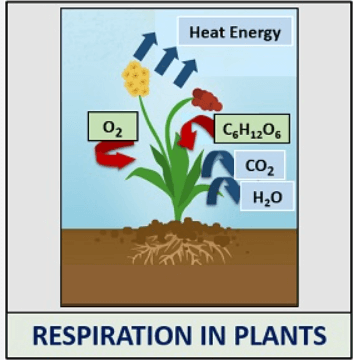
Remember, while preparation plants also photosynthesize during the day (in the presence of light), where they use sunlight, water, and carbon dioxide to produce Glucose and oxygen. This intricate balance between preparation and photosynthesis ensures the plant’s survival and growth.
Process of Respiration in Plants
Here’s a step-by-step process of respiration in plants. These steps collectively enable plants to generate energy in the form of ATP, necessary for their growth, maintenance, and various biological processes. However it is very important to note that anaerobic respiration can occur in the absence of oxygen, but it’s less efficient than aerobic respiration. In anaerobic respiration, glycolysis is followed by different pathways to regenerate NAD+ from NADH, allowing glycolysis to continue. One common product of anaerobic respiration in plants is ethanol, especially in situations like Fermentation.
| Steps Involved in the Process of Respiration in Plants | |||
| Steps | Location | Input | Output |
| 1. Glycolysis | Cytoplasm | Glucose (6C) | 2 Pyruvate (3C), 2 ATP, 2NADH. |
| 2. Transition Reaction (Aerobic Respiration) | Mitochondria | 2 Pyruvate (3C) | 2 Acetyle-CoA, 2 CO2 |
| 3. Krebs Cycle (Citric Acid Cycle) | Mitochondria | 2 Acetyl-CoA (2C) | CO2, ATP, NADH, FADH2, 2 Acetyl-CoA regenerated |
| 4. Oxidative Phosphorylation (ETC) | Mitochondrial Membrane | NADH, FADH2, O2 | ATP, H2O, NAD+, FAD |
Step 1: Glycolysis – The process starts in the cytoplasm of the plant cell, where one molecule of glucose (a 6-carbon sugar) is broken down into two molecules of pyruvate (a 3-carbon compound). This step doesn’t require oxygen and is common to both aerobic and anaerobic respiration.
Step 2: Transition Reaction (Aerobic Respiration) – In aerobic respiration, the pyruvate molecules produced in glycolysis move into the mitochondria. There, each pyruvate molecule is converted into acetyl-CoA, releasing carbon dioxide in the process.
Step 3: Kreb Cycle (Citric Acid Cycle) – Acetyl-CoA enters the Krebs Cycle, a series of chemical reactions that occur in the Mitochondria. During this cycle, acetyl-CoA is further broken down, releasing carbon dioxide and transferring high-energy electrons to carrier molecules.
Step 4: Oxidative Phosphorylation (Electron Transport Chain) – The high-energy electrons carried by molecules like NADH and FADH2 move through the electron transport chain, located in the inner membrane. As electrons pass through the chain, they release energy, which is used to pump protons (H+ ions) across the membrane, creating an electrochemical gradient.
Step 5: ATP Synthesis – The electrochemical gradient created by the proton pumping drives the synthesis of ATP from ADP (adenosine diphosphate) and inorganic phosphate. This process is known as chemiosmosis and occurs in the mitochondria. ATP is the energy currency of the cell and is used for various cellular activities.
Step 6: Water Formation – Oxygen molecules (O2) serve as the final electron acceptors in the electron transport chain. When oxygen accepts electrons and combines with protons, water (H2O) is formed as a byproduct.
Respiration in leaves
Respiration in leaves is a bit like breathing for plants. Just as humans breathe in oxygen and release carbon dioxide, leaves take in air through tiny pores called stomata. Inside the leaf cells, oxygen is used to break down sugars, created through Photosynthesis, into energy the plant can use. This energy is essential for the plant’s growth and other activities. During this process, leaves also release carbon dioxide back into the air, which is a byproduct of respiration. So, in simple terms, leaves breathe in air, use oxygen to get energy from sugars, and then breathe out carbon dioxide.
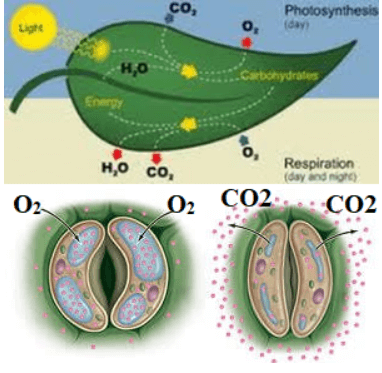
Stomata
Stomata are small openings, like tiny mouths, found on the surface of plant leaves and stems. These openings allow plants to exchange gases with the surrounding atmosphere. Through stomata, plants can take in carbon dioxide, which is essential for photosynthesis, the process plants use to make food. At the same time, stomata also enable plants to release oxygen, a byproduct of photosynthesis.
During respiration, leaves use oxygen to break down sugars and other organic molecules to generate energy for the plants. Stomata allow the entry of oxygen from the surrounding air into the leaf cells, where it is used in the respiration process. At the same time, carbon dioxide produced during respiration is released through these stomatal openings into the atmosphere. So, stomata facilitate the exchange of gases needed for respiration in leaves, ensuring the plants can produce energy and sustain their life processes.
Respiration in Stems
Respiration in stems, like in other plant parts, involves the process of cellular respiration. During cellular respiration, cells break down organic molecules, such as sugars, to release energy for essential life processes. In stems, just as in leaves and other plant tissues, this energy is used for various activities like growth, maintenance, and Reproduction. Many woody plants have Lenticles on their stems. Lenticels are small, specialized pores or openings in the bark of woody plants, including stems. They are involved in gas exchange allowing the plant to take in oxygen for cellular respiration and release carbon dioxide, a byproduct of respiration.
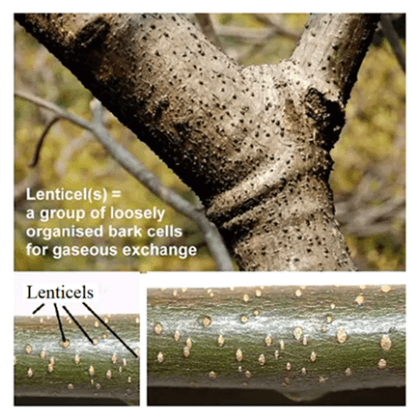
Stems have specialized tissues called vascular tissues, which include the xylem and phloem. Xylem transports water and minerals from the roots to the rest of the plants, while phloem transports sugars and other organic molecules produced during photosynthesis from the leaves to other parts of the plant, including stems. In stems, cells respire by taking in oxygen and breaking down glucose (or other organic compounds) to produce energy, carbon dioxide, and water. This process occurs in all living cells, including those in stems, to sustain the plant’s life processes.
Respiration in Roots
Respiration in roots is like the plant’s way of breathing and eating at the same time. Roots take in oxygen from the soil and use it to transform food (sugars) into energy, just like we do when we eat. This energy helps the plant grow and do all the things it needs to do to stay alive. As a result of this process, roots also release some waste products like carbon dioxide and water into the soil.
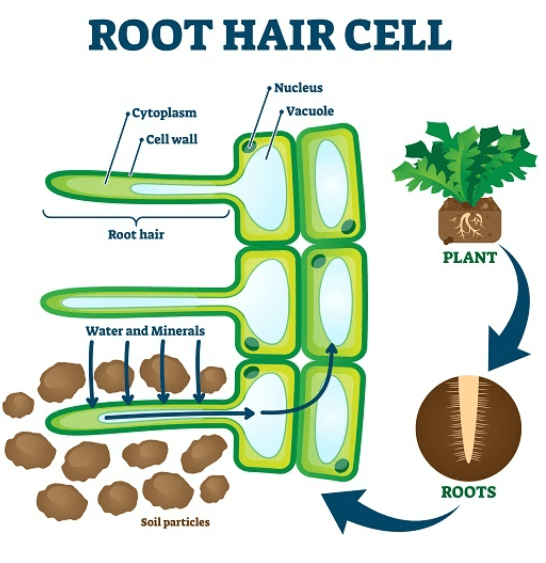
Roots have specialized structures, such as root hairs, which increase the surface area for the absorption of water and minerals from the soil. Once these water and mineral molecules are absorbed, they are transported to root cells where they undergo respiration to release energy.
During respiration, oxygen is taken in by the root cells, and organic molecules, usually glucose, are oxidized to produce energy in the form of ATP (adenosine triphosphate). This energy is essential for processes like nutrient uptake, growth, and maintenance of the plant. In addition to energy, respiration in roots also produces carbon dioxide and water as byproducts, which are released back into the soil.
Types of Respiration in Plants
Plants mainly exhibit two types of respiration: Aerobic Respiration and Anaerobic Respiration. Both types of respiration are essential for the energy metabolism of plant cells, allowing them to survive and grow in various environmental conditions.
| Types of Respiration in Plants | |||
| Respiration Types | Location | Reactants | Products |
| Aerobic Respiration | Mitochondria | Glucose + Oxygen | Energy + Carbon Dioxide + Water |
| Anaerobic Respiration | Cytoplasm | Glucose (in the presence of oxygen) | Energy + Lactic Acid (or ethanol depending on plant species) |
Aerobic Respiration
Similar to animals, aerobic respiration in plants occurs in the presence of oxygen. During aerobic respiration, glucose, and oxygen are used to produce energy, carbon dioxide, and water. This process takes place in the mitochondria of plant cells.
Anaerobic Respiration
In the absence of oxygen, plants can undergo anaerobic respiration. This process is less efficient and occurs in the cytoplasm of plant cells. Anaerobic respiration in plants usually leads to the production of energy, lactic acid, or ethanol, depending on the plant species.

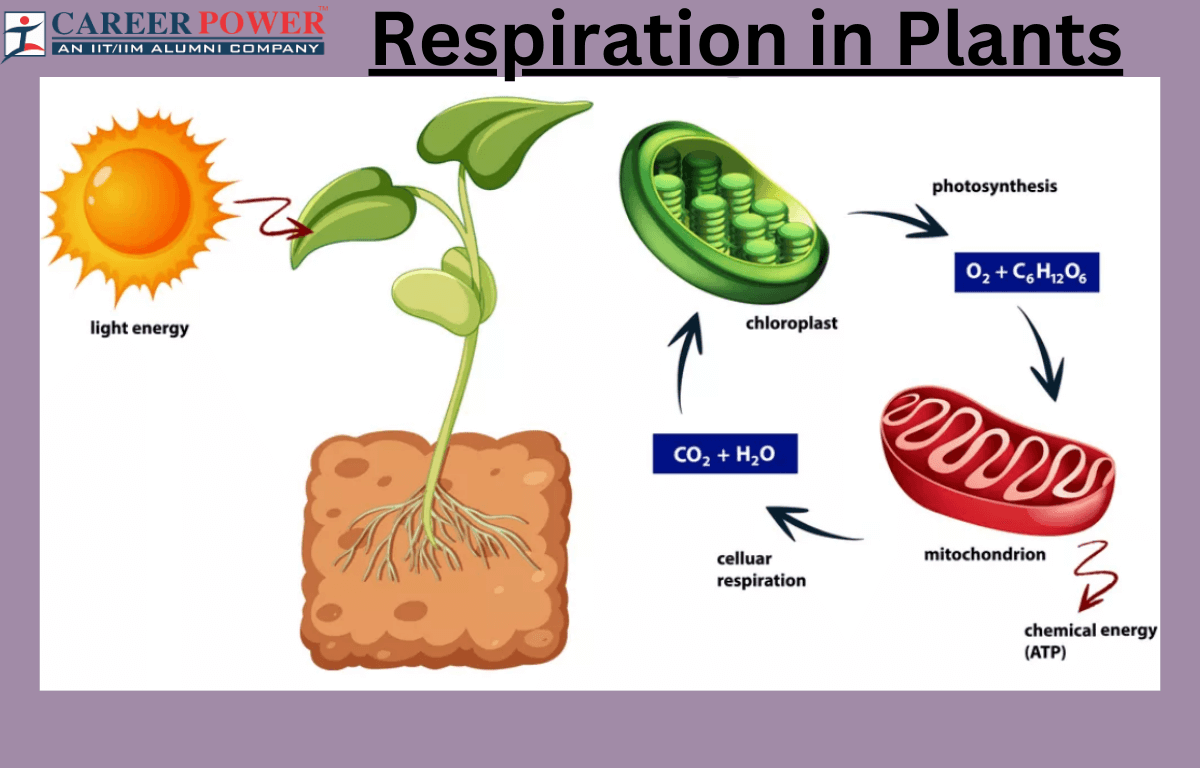

 50 Vegetables Name for Kids in English a...
50 Vegetables Name for Kids in English a...
 Food Chain: Definition, Types, Examples,...
Food Chain: Definition, Types, Examples,...
 Human Respiratory System: Definition, Di...
Human Respiratory System: Definition, Di...













